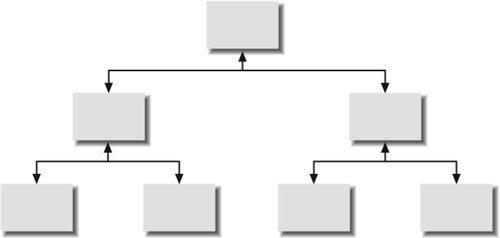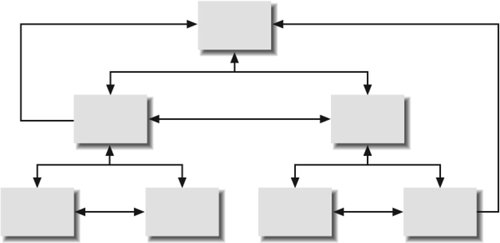Section 7.5. Improving Flexibility
7.5. Improving FlexibilityAs we explained in Chapter 5, hierarchy is a familiar and powerful way of organizing information. In many cases, it makes sense for a hierarchy to form the foundation for organizing content in a web site. However, hierarchies can be limiting from a navigation perspective. If you have ever used the ancient information-browsing technology and precursor to the World Wide Web known as Gopher, you will understand the limitations of hierarchical navigation.[
Figure 7-5. The pure hierarchy of Gopherspace The Web's hypertextual capabilities removed these limitations, allowing tremendous freedom of navigation. Hypertext supports both lateral and vertical navigation. From any branch of the hierarchy, it is possible and often desirable to allow users to move laterally into other branches, to move vertically from one level to a higher level in that same branch, or to move all the way back to the main page of the web site. If the system is so enabled, users can get to anywhere from anywhere. However, as you can see in Figure 7-6, things can get confusing pretty quickly. It begins to look like an architecture designed by M.C. Escher. Figure 7-6. A hypertextual web can completely bypass the hierarchy The trick to designing navigation systems is to balance the advantages of flexibility with the dangers of clutter. In a large, complex web site, a complete lack of lateral and vertical navigation aids can be very limiting. On the other hand, too many navigation aids can bury the hierarchy and overwhelm the user. Navigation systems should be designed with care to complement and reinforce the hierarchy by providing added context and flexibility. |
EAN: 2147483647
Pages: 194
 ] In Gopherspace, you were forced to move up and down the tree structures of content hierarchies (see Figure 7-5). It was impractical to encourage or even allow jumps across branches (lateral navigation) or between multiple levels (vertical navigation) of a hierarchy.
] In Gopherspace, you were forced to move up and down the tree structures of content hierarchies (see Figure 7-5). It was impractical to encourage or even allow jumps across branches (lateral navigation) or between multiple levels (vertical navigation) of a hierarchy.  ] If youre too young to remember Gopher, consider the category/subcategory navigation on an iPod instead.
] If youre too young to remember Gopher, consider the category/subcategory navigation on an iPod instead.